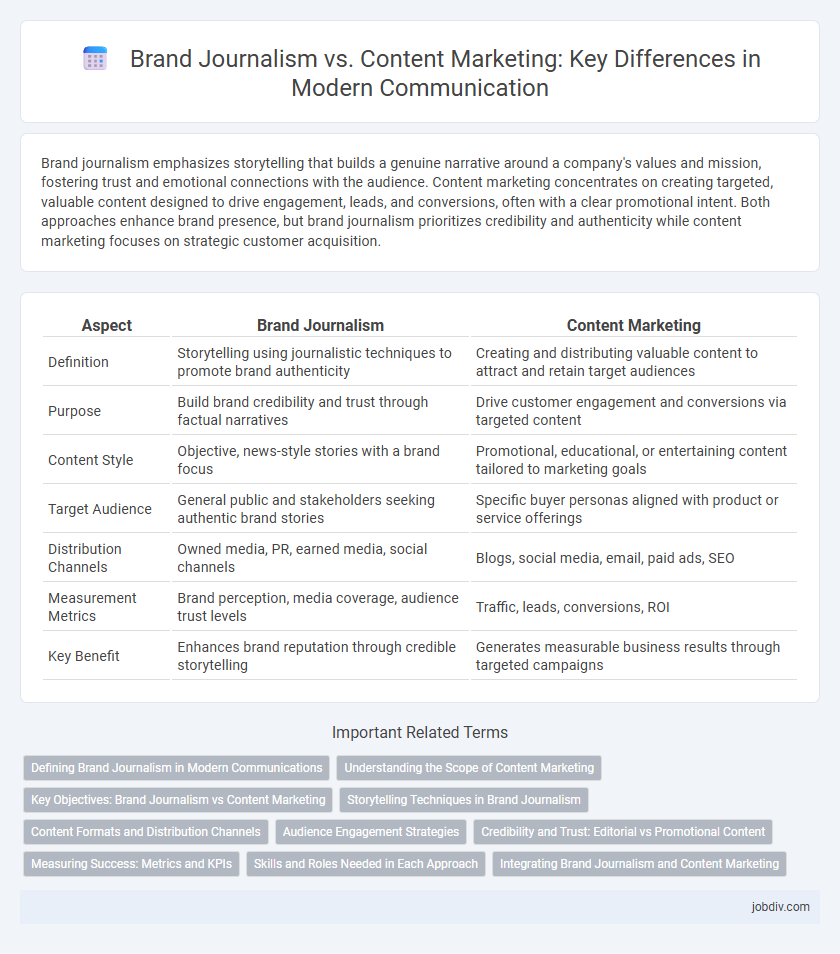Brand journalism emphasizes storytelling that builds a genuine narrative around a company's values and mission, fostering trust and emotional connections with the audience. Content marketing concentrates on creating targeted, valuable content designed to drive engagement, leads, and conversions, often with a clear promotional intent. Both approaches enhance brand presence, but brand journalism prioritizes credibility and authenticity while content marketing focuses on strategic customer acquisition.
Table of Comparison
| Aspect | Brand Journalism | Content Marketing |
|---|---|---|
| Definition | Storytelling using journalistic techniques to promote brand authenticity | Creating and distributing valuable content to attract and retain target audiences |
| Purpose | Build brand credibility and trust through factual narratives | Drive customer engagement and conversions via targeted content |
| Content Style | Objective, news-style stories with a brand focus | Promotional, educational, or entertaining content tailored to marketing goals |
| Target Audience | General public and stakeholders seeking authentic brand stories | Specific buyer personas aligned with product or service offerings |
| Distribution Channels | Owned media, PR, earned media, social channels | Blogs, social media, email, paid ads, SEO |
| Measurement Metrics | Brand perception, media coverage, audience trust levels | Traffic, leads, conversions, ROI |
| Key Benefit | Enhances brand reputation through credible storytelling | Generates measurable business results through targeted campaigns |
Defining Brand Journalism in Modern Communications
Brand journalism in modern communications is a strategic storytelling approach that focuses on creating authentic, newsworthy content to engage audiences and build brand credibility. Unlike traditional advertising, it emphasizes transparency and factual narratives that resonate emotionally while informing consumers. This method leverages journalistic principles to craft compelling stories that align with brand values and enhance trust in a crowded digital landscape.
Understanding the Scope of Content Marketing
Content marketing encompasses a broad range of strategies that involve creating and distributing valuable, relevant, and consistent content to attract and engage a target audience. Unlike brand journalism, which focuses on storytelling and authentic brand narratives, content marketing aims to drive specific business goals such as lead generation, customer retention, and brand awareness through diverse formats like blogs, videos, and social media posts. This expansive scope allows content marketing to integrate SEO, data analytics, and multi-channel campaigns to optimize reach and measurable impact.
Key Objectives: Brand Journalism vs Content Marketing
Brand journalism focuses on storytelling that builds a credible narrative around a brand's values and mission, aiming to earn trust and engagement through authentic, newsworthy content. Content marketing targets customer acquisition and retention by creating valuable, relevant content designed to drive conversions and support specific business goals. Both strategies enhance brand visibility, but brand journalism prioritizes reputation and thought leadership while content marketing emphasizes measurable marketing outcomes.
Storytelling Techniques in Brand Journalism
Brand journalism employs authentic storytelling techniques to build emotional connections by highlighting real stories, company values, and customer experiences, fostering trust and credibility. It uses narrative arcs derived from journalistic principles, such as conflict, resolution, and character development, to engage audiences deeply. Unlike content marketing's promotional tone, brand journalism prioritizes informative, transparent storytelling that positions the brand as a reliable source.
Content Formats and Distribution Channels
Brand journalism emphasizes storytelling through in-depth articles, interviews, and documentaries distributed primarily via owned media such as company websites and social media platforms. Content marketing leverages diverse formats including blogs, infographics, videos, and email newsletters, with distribution extending to paid media, social networks, and third-party platforms to maximize reach and engagement. Effective communication strategies integrate both approaches to target specific audiences across multiple digital channels.
Audience Engagement Strategies
Brand Journalism leverages storytelling and journalistic integrity to build trust and foster emotional connections, creating authentic narratives that resonate deeply with audiences. Content Marketing employs targeted, data-driven campaigns to deliver relevant, valuable information that drives engagement through personalized experiences and optimized distribution channels. Both strategies prioritize audience engagement but differ in approach: Brand Journalism emphasizes credibility and narrative immersion, while Content Marketing focuses on conversion and measurable interaction metrics.
Credibility and Trust: Editorial vs Promotional Content
Brand journalism emphasizes editorial content rooted in fact-based storytelling that builds credibility and fosters trust by delivering authentic narratives. Content marketing often features promotional content designed to drive sales, which can sometimes compromise perceived trustworthiness among discerning audiences. Leveraging brand journalism's journalistic standards enhances audience engagement through transparency and reliable information.
Measuring Success: Metrics and KPIs
Brand journalism measures success through engagement metrics such as audience reach, storytelling impact, and brand sentiment analysis, emphasizing authentic connection and trust building. Content marketing focuses on KPIs like conversion rates, click-through rates (CTR), lead generation, and return on investment (ROI) to quantify the effectiveness of content in driving sales or actions. Both strategies utilize analytics tools, but brand journalism prioritizes qualitative insights while content marketing centers on quantitative performance indicators.
Skills and Roles Needed in Each Approach
Brand journalism requires skills in investigative reporting, storytelling, and journalistic ethics to create credible, newsworthy content that builds brand trust. Content marketing demands expertise in SEO, audience analysis, and multimedia production to craft engaging, targeted campaigns that drive conversions. While brand journalists focus on authentic narratives grounded in facts, content marketers prioritize strategic promotion and measurable results.
Integrating Brand Journalism and Content Marketing
Integrating brand journalism and content marketing creates a powerful communication strategy that combines authentic storytelling with targeted audience engagement. This approach leverages journalistic principles to produce credible, newsworthy content while aligning with marketing goals to drive brand awareness and customer loyalty. Effective integration ensures consistent messaging, strengthens brand identity, and enhances consumer trust through relevant and valuable content across multiple channels.
Brand Journalism vs Content Marketing Infographic

 jobdiv.com
jobdiv.com